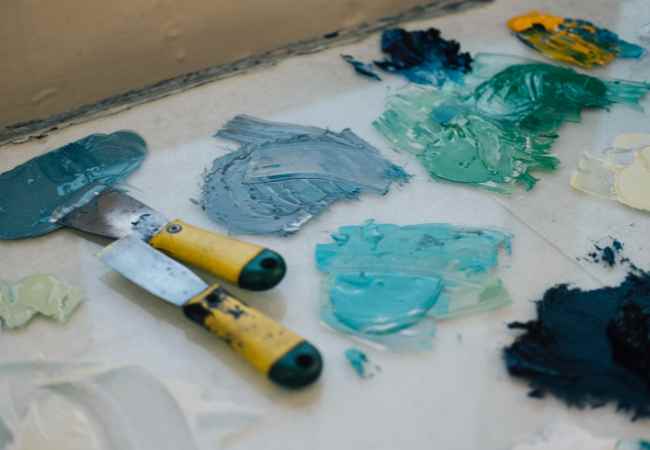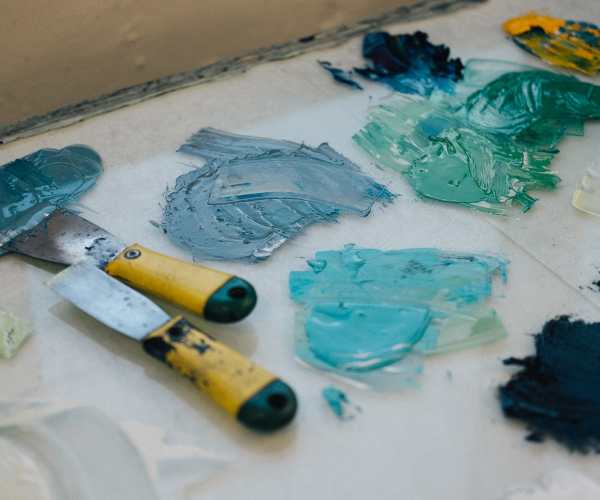Printmaking is that fascinating art form wherein creativity merges with communication. It’s more than creating images, inasmuch as it involves story-telling, message-passing and interaction via art. An artist’s delicate etchings and screen prints are more than meets the eye, there’s a story behind them that is conceptualized into their art form.
On the other hand; an artistic process like print making requires use of inks which is highly toxic to both the artist as well as the environment. Non-toxic inks step in here. Non-toxic inks are novel inks that are in tandem with artistic motivation without compromising on the integrity.
Why then should we bother about the place of non-toxic inks within printmaking? Non-toxic inks boast of numerous advantages. These have the potential of making the artistic workspace less hazardous and damaging to the environment. In this post we are going to consider various techniques within the printmaking process where non-toxic inks could be used without harming the environment making this world a better place.

Why Choose Non-Toxic Inks?
The Environmental Impact of Traditional Inks
Let’s tackle the main problem right away: conventional inks can be pretty nasty for our home planet. As a rule, mass of inks on the market or even in a local stores are formulated with fuels, which posses great harm when emitted in production.
Remember – when we talk about prints, we don’t bend the meaning of putting ink into paper only; rather pungent effects are also ascribed in the lifespan of those materials. Practically any conventional ink’s manufacturing entails the introduction of different pollutants into the air and water bodies which has a direct impact on creative practitioners and the regions in the vicinity of printmaking facilities.
If these inks are not properly disposed of, they are taken to the landfill, where they seep chemicals into the earth. I recall being at a workshop where an artist discussed with us what they do with old inks and what the best practices are. To prevent ecological abuse, they were forced to use very strict procedures and regulations, which made treating the inks somewhat inconvenient and quite depressing.
Making use of non-toxic inks seems to be the future as switching to them can help make a great difference. Non toxic inks are made from renewable sources and have no harmful substances in them. Using such inks can be considered a way to help protect the planet!
Advantages for both consumers as well as the artists
As an artist, it is very easy to get engrossed too much in the process of creation and forget about the consequences of the materials being used. The same does not stand true for the traditional inks as most of them have solvents and heavy metals in them which can be hazardous to one’s health if inhaled or absorbed through the skin.
It is common to hear artists complain about getting headaches, skin problems, or respiratory troubles when working with traditional inks, especially after long printing sessions. On the other hand, a close friend of mine who had used only a conventional ink printer for years suffered from constant migraines before she completely turned to non toxic inks which amazed her as well as me because she felt drastic changes in her life. I’ve heard about her experience multiple times, but I never grow tired of it.
To envision an art environment where you don’t have to worry about sniffs or chemicals interfering with the process is simply remarkable! Non toxic inks are perfect for anyone looking to escape the constant worry especially artists which allows for a patience free environment which is wonderful especially for creating art.
Quality of Prints
Now, with regard to quality, who wouldn’t want to have stunning prints at the end of the day? A small point of concern is that most people do tend to think that non-toxic inks would be dull compared to regular inks. I can, however, guarantee you that I wouldn’t be farther away from the truth than that.
From my personal perspective, I would say that non-toxic inks could be more vibrant than toxic inks. One great thing about non-toxic inks is that they print well with high saturation even on fine details.
Soy based ink is used by a local artist who I greatly admire for her impressive linocuts. The strength of color and the clarity of the images she produced blew me away! She mentioned that not only do these inks create spectacular inks suitable for encouraging layering techniques, these inks also improve the transparency of the glasses.
The list of global non-toxic ink manufacturers is increasing day by day. This group of manufacturers is producing earth-friendly inks which are much safer for the environment and public, allowing us to keep our planet safe.
Non Toxic Inks Type
Eco-Solvent Inks
A well-known and widely used non-toxic ink is eco solvent inks. There are three main solvents used to produce eco solvent ink: ethanol, marks and methyl. These four solvents have relatively low odour and allow for a more pleasant working environment.
Eco solvent inks have some limitations, though they are quite reasonable. Eco solvent ink costs more than other conventional inks. Also, these kinds of inks need to be properly maintained as mismanagement can lead to clogging of the printhead. However, with the proper care of the machine, solvents promise to provide good quality prints. Furthermore, eco solvent inks have excellent adhesion which make them suitable for both indoor and outdoor use.
Water-based ink also has the added benefit of being odorless and allowing users to enjoy long creative hours without being stifled by chemical fumes. It reminds me of a period I spent at a small print studio that was made stressful and uncomfortable by the overwhelming stink that came from intimidate inks. The air is cleaner now that we have transitioned to using these water-based inks. We can concentrate on making art more easily without being clouded by it.
Soy Inks
Soybean ink is composed of natural elements and can be recycled; it is made with a renewable resource. Eco-friendly production of prints that benefit the environment sounds incredible, doesn’t it? That is the primary advantage that soybean ink has over traditional ink.
Artists praise this type of ink for its deep coloring effect, high visibility, and glossy finish as opposed to traditional types of ink. Though these inks do pose certain drawbacks in certain situations, they are still extremely good overall. Last year at a print fair, I met a fine artist who exclusively applied soyabean ink in her screen prints. The colors were so bright and vibrant they almost appeared to be in 3D.
Today, it is becoming increasingly widespread because printshops recognize its intrinsic benefits, and eco printing companies rely on it. I met a small print shop owner who started using soy-based inks. As a result, novel clients including eco-conscious customers emerged, leading to improved print quality and aiding in environmental conservation greatly San Jose Printer.
Other Eco-Friendly Options
Apart from water-based and soy-based inks, there are other eco-friendly inks which the artists working in printmaking industry can use. For example, vegetable inks are quickly gaining traction within the industry. These inks are made from natural sources and provide another sustainable option for artists.
These inks are gaining traction among the printmaking community. There is heightened awareness of the environmental impact of some materials that are artists, and people are looking out more for the materials that they use. In my experience, I have seen how the art communities are accepting transitions to eco friendly inks while at the workshops and galleries, encouraging each other with tips and experiences and working together towards non toxic soya inks.
How to transition to non-toxic inks
Steps for Artists
So, now that you have decided to make that shift to no-tox inks, do not be daunted by the amount of work you still need to do. The transition will be smoothly for you! Here’s a detailed procedure on what to do next:
Educate Yourself: Track the major brands for non toxic inks available in the market and their local dealers. Develop a thorough understanding of the properties and compositions so that you are able to select what best meets your practice.
Experiment: Acquire water and soy-based inks in small quantities use to mix into your print in the making. This way, you can verify if they suit your methods of working.
Refine Your Methods: You may need to change your printing methods a bit. Water based inks for example, will need quicker printing because of their quick drying times. Feel free to contact other artists for help!
Get New Equipment: You might want to buy squeegees and rollers for non toxic inks, provided these are missing from your set up already, as these two work particularly well with water based inks.
Proper Cleanup: Use soap and water to clean up and enjoy the luxury of not having to soak in solvents. This will not only help your workstation but will also promulgate maintaining a clean and healthy studio.
Supplier Recommendations
It is wise to look for suppliers of non toxic inks that have proper proof for selling good quality and environmentally sustainable products.
Here are a few recommendations:
Speedball Art Products – They have wide range of water and soy based inks and are fully committed in providing eco-friendly products.
Daniel Smith – Non-toxic inks and paints are offered and serve diverse purpose for artists.
Kremer pigment – These offer a series of earth and natural pigments best suited for print making along with a range of specialized, non toxic pigments.
When buying, of course you want to check for eco-labels or any sign that certifies that the inks being used are eco-friendly. For example, there’s a Green Seal, EcoLogo etc. These labels assure you that the inks you use are in accordance with your beliefs.
FAQs
What materials are used non toxic inks made of?
Great question! Non toxic inks are mostly produced of materials that are Natural and sustainable.
For example, Water-based inks are a type of paint that consists of water, pigments, and resins but in an environment friendly way.
Whereas, Soybeans are used to produce soy soy ink which is then treated in paste for quality printing use.
In a nutshell, non toxic inks discontinue the use of petroleum based kinds of inks which emit volatiles. Such a switch is good for the environment and care for the printmakers and artists well being. That one time I got my hands on these inks, I felt like I’ve been set free from a cage, simply because I made a better choice for myself and Mother Nature.
Are non-toxic inks as vibrant as traditional inks?
Indeed! Non toxic inks have a common misbelief that they are not as saturated in color as the rest of the inks.
In my view, I have come to know that most non-toxic inks, particularly those derived via soy and other vegetables, are capable of producing the same level of intensity in color.
For instance, I was taken aback when the colors I used on my block while using soy inks were really vibrant and attractive. They tend to be quite striking when printed on paper!
Also, artists in general claim to be able to reproduce stunning images with even one practice while using non-toxic inks, which looks quite similar to those made with traditional inks. It is predominantly about which brand you are going for and how well you can use it to its fullest potential.
Non-toxic inks and printmaking; which ways are they compatible?
In the world of printmaking, non-toxic inks do have their differences from the regular inks.
The first difference that you may find is in the water based inks as they are known for drying quite quickly, which could be both a blessing and a curse.
On the positive side, you are able to work quite fast and add multiple layers without the concern of ink making prints blurry.
One downside of this is that it requires you to be a little more dexterous with the approaches as mentioned before.
To illustrate, I found it quite difficult to manage the timings when I was using a water based ink and applying multiple layers of it.
Another thing to consider is that non-toxic inks might require different cleansing methods. Non-toxic inks can usually be washed with soap and water, making the process easier and less harmful. Therefore, it is a trade-off well worth taking up especially if you wish to work in a cleaner setting.
Are non-toxic inks suitable for all printmaking processes?
Non-toxic inks are definitely suitable for a number of printmaking uses, but then again there are limitations to what can and cannot be done.
As an instance, screen and relief printing tend to work with non-toxic inks pretty well owing to their general properties of being consistent while being applied.
For other techniques such as lithography, a little education may be required. Certain artists have successfully used non-toxic inks in lithography but proper formulations that fit this technique should be created.
I have also known print makers who have successfully used non-toxic inks for monotype and etching processes.
At the end of the day, it’s about testing different inks and figuring out what fits your style and technique the most. The art world is so supportive so always feel free to talk to other artists and ask them about this and that because it is true that knowledge grows when shared.
Conclusion
To conclude, it is important to note that the use of non-toxic inks in printmaking is beneficial on so many levels.
These inks reduce the exposure of the artists to toxic chemicals and in that context, they are healthier. Furthermore, they enable eco practices by reducing the negative effects on the environment of the art.
Water based inks, soy based inks and other green options can still give your prints vibrancy without going through huge changes.
I want everyone to actively switch to green options as it will benefit you and the environment.
Did you use non-toxic inks in your printmaking? I would be happy to hear what your experiences were, what tips you would give, or what brands you would recommend. Please do not hesitate to write it all in the comments below.






